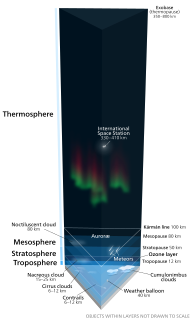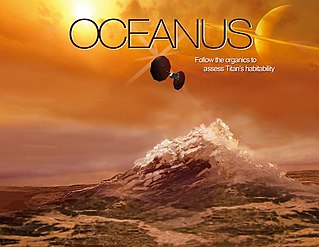Related Research Articles

The ionosphere is the ionized part of Earth's upper atmosphere, from about 48 km (30 mi) to 965 km (600 mi) altitude, a region that includes the thermosphere and parts of the mesosphere and exosphere. The ionosphere is ionized by solar radiation. It plays an important role in atmospheric electricity and forms the inner edge of the magnetosphere. It has practical importance because, among other functions, it influences radio propagation to distant places on the Earth.

An ion thruster, ion drive, or ion engine is a form of electric propulsion used for spacecraft propulsion. It creates thrust by accelerating ions using electricity.

Atmospheric entry is the movement of an object from outer space into and through the gases of an atmosphere of a planet, dwarf planet, or natural satellite. There are two main types of atmospheric entry: uncontrolled entry, such as the entry of astronomical objects, space debris, or bolides; and controlled entry of a spacecraft capable of being navigated or following a predetermined course. Technologies and procedures allowing the controlled atmospheric entry, descent, and landing of spacecraft are collectively termed as EDL.

Outer space is the expanse that exists beyond Earth and between celestial bodies. Outer space is not completely empty—it is a hard vacuum containing a low density of particles, predominantly a plasma of hydrogen and helium, as well as electromagnetic radiation, magnetic fields, neutrinos, dust, and cosmic rays. The baseline temperature of outer space, as set by the background radiation from the Big Bang, is 2.7 kelvins. The plasma between galaxies is thought to account for about half of the baryonic (ordinary) matter in the universe, having a number density of less than one hydrogen atom per cubic metre and a temperature of millions of kelvins. Local concentrations of matter have condensed into stars and galaxies. Studies indicate that 90% of the mass in most galaxies is in an unknown form, called dark matter, which interacts with other matter through gravitational but not electromagnetic forces. Observations suggest that the majority of the mass-energy in the observable universe is dark energy, a type of vacuum energy that is poorly understood. Intergalactic space takes up most of the volume of the universe, but even galaxies and star systems consist almost entirely of empty space.

The Galaxy Evolution Explorer (GALEX) was an orbiting ultraviolet space telescope which was launched on 28 April 2003 and operated until early 2012.

The Discovery Program is a series of solar system exploration missions funded by the US National Aeronautics and Space Administration (NASA) through its Planetary Missions Program Office. The cost of each mission is capped at a lower level than missions from NASA's New Frontiers or Flagship Programs. As a result, Discovery missions tend to be more focused on a specific scientific goal rather than serving a general purpose.
The Lockheed Martin Solar and Astrophysics Laboratory (LMSAL) is part of the Lockheed Martin Advanced Technology Center (ATC) that is known primarily for its scientific work in the field of solar physics, astronomy and space weather. The LMSAL team is part of Lockheed Martin Space Systems and has close affiliations with NASA and the solar physics group at Stanford University.

C/NOFS, or Communications/Navigation Outage Forecasting System was an American satellite developed by the Air Force Research Laboratory Space Vehicles Directorate to investigate and forecast scintillations in the Earth's ionosphere. It was launched by an Orbital Sciences Corporation Pegasus-XL rocket at 17:01 GMT on 16 April 2008 and decayed on 28 November 2015.

The Gravity and Extreme Magnetism SMEX (GEMS) mission was a cancelled space observatory mission. The main scientific goal of GEMS was to be the first mission to systematically measure the polarization of cosmic X-Ray sources. GEMS would have provided data to help scientists study the shape of spacetime that has been distorted by a spinning black hole's gravity and the structure and effects of the magnetic fields around neutron stars. It was cancelled by NASA in June 2012 for potential cost overruns due to delays in developing the technology.
Io Volcano Observer (IVO) is a proposed low-cost, outer-planet mission to explore Jupiter's moon Io to understand tidal heating as a fundamental planetary process. The main science goals are to understand (A) how and where tidal heat is generated inside Io, (B) how tidal heat is transported to the surface, and (C) how Io is evolving. These results are expected to have direct implications for the thermal history of Europa and Ganymede as well as provide insights into other tidally heated worlds such as Titan and Enceladus. The IVO data may also improve our understanding of magma oceans and thus the early evolution of the Earth and Moon.

The Interface Region Imaging Spectrograph (IRIS), also called Explorer 94, is a NASA solar observation satellite. The mission was funded through the Small Explorer program to investigate the physical conditions of the solar limb, particularly the interface region made up of the chromosphere and transition region. The spacecraft consists of a satellite bus and spectrometer built by the Lockheed Martin Solar and Astrophysics Laboratory (LMSAL), and a telescope provided by the Smithsonian Astrophysical Observatory. IRIS is operated by LMSAL and NASA's Ames Research Center.

Mars Exploration Program (MEP) is a long-term effort to explore the planet Mars, funded and led by NASA. Formed in 1993, MEP has made use of orbital spacecraft, landers, and Mars rovers to explore the possibilities of life on Mars, as well as the planet's climate and natural resources. The program is managed by NASA's Science Mission Directorate by Doug McCuistion of the Planetary Science Division. As a result of 40% cuts to NASA's budget for fiscal year 2013, the Mars Program Planning Group (MPPG) was formed to help reformulate the MEP, bringing together leaders of NASA's technology, science, human operations, and science missions.
The Ionospheric Connection Explorer (ICON) is a satellite designed to investigate changes in the ionosphere of Earth, the dynamic region high in our atmosphere where terrestrial weather from below meets space weather from above. ICON studies the interaction between Earth's weather systems and space weather driven by the Sun, and how this interaction drives turbulence in the upper atmosphere. It is hoped that a better understanding of this dynamic will mitigate its effects on communications, GPS signals, and technology in general. It is part of NASA's Explorers program and is operated by University of California, Berkeley's Space Sciences Laboratory.

Global-scale Observations of the Limb and Disk (GOLD) is a heliophysics Mission of Opportunity (MOU) for NASA's Explorers program. Led by Richard Eastes at the Laboratory for Atmospheric and Space Physics, which is located at the University of Colorado Boulder, GOLD's mission is to image the boundary between Earth and space in order to answer questions about the effects of solar and atmospheric variability of Earth's space weather. GOLD was one of 11 proposals selected, of the 42 submitted, for further study in September 2011. On 12 April 2013, NASA announced that GOLD, along with the Ionospheric Connection Explorer (ICON), had been selected for flight in 2017. GOLD, along with its commercial host satellite SES-14, launched on 25 January 2018.

The Heliophysics Science Division of the Goddard Space Flight Center (NASA) conducts research on the Sun, its extended solar system environment, and interactions of Earth, other planets, small bodies, and interstellar gas with the heliosphere. Division research also encompasses geospace—Earth's uppermost atmosphere, the ionosphere, and the magnetosphere—and the changing environmental conditions throughout the coupled heliosphere.

DAVINCI+ is a planned mission for an orbiter and atmospheric probe to the planet Venus. Together with the VERITAS mission, which will also study Venus, it was selected by NASA on 2 June 2021 to be part of their Discovery Program.

Oceanus is a NASA/JPL orbiter mission concept proposed in 2017 for the New Frontiers mission #4, but it was not selected for development. If selected at some future opportunity, Oceanus would travel to Saturn's moon Titan to assess its habitability. Studying Titan would help understand the early Earth and exoplanets which orbit other stars. The mission is named after Oceanus, the Greek god of oceans.
CubeSat UV Experiment (CUVE) is a space mission concept to study the atmospheric processes of the planet Venus with a small satellite. Specifically, the orbiter mission would study an enigmatic ultraviolet light absorber of unknown composition situated within the planet's uppermost cloud layer that absorbs about half the solar radiation downwelling in the planet's atmosphere.
Polarimeter to Unify the Corona and Heliosphere (PUNCH) is a future mission by NASA to study the unexplored region from the middle of the solar corona out to 1 AU from the Sun. PUNCH will consist of a constellation of four microsatellites that through continuous 3D deep-field imaging, will observe the corona and heliosphere as elements of a single, connected system. The four microsatellites are planned to be launched in October 2023, along with a pair of secondary satellites named Tandem Reconnection and Cusp Electrodynamics Reconnaissance Satellites (TRACERS).
Tandem Reconnection and Cusp Electrodynamics Reconnaissance Satellites (TRACERS) is a planned orbiter mission tasked to study the origins of the solar wind and how it affects Earth. The Principal Investigator is Craig Kletzing at the University of Iowa in Iowa City, Iowa. Not including rideshare costs, TRACERS is funded US$115 million.
References
- 1 2 NASA - NASA Selects Science Investigations For Concept Studies.
- ↑ The Atmosphere-Space Transition Region Explorer (ASTRE) -- Using in situ Measurements on a Low Perigee Satellite to Understand How the Upper Atmosphere and Magnetosphere are Coupled. Robert F Pfaff Jr. Triennial Earth-Sun Summit.
- ↑ Atmosphere-Space Transition Region Explorer (ASTRE). Robert F. Pfaff. 11 December 2011. Transcription from a presentation.
